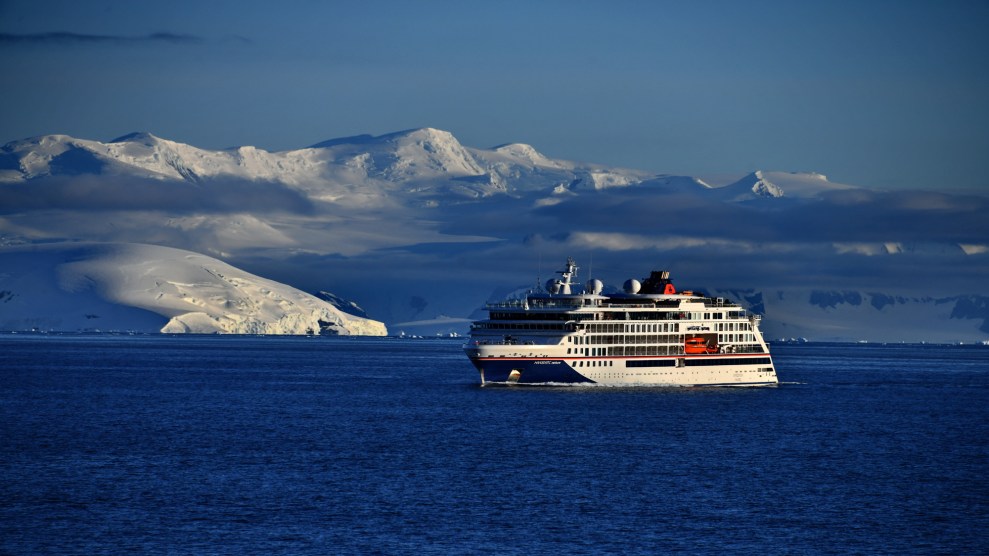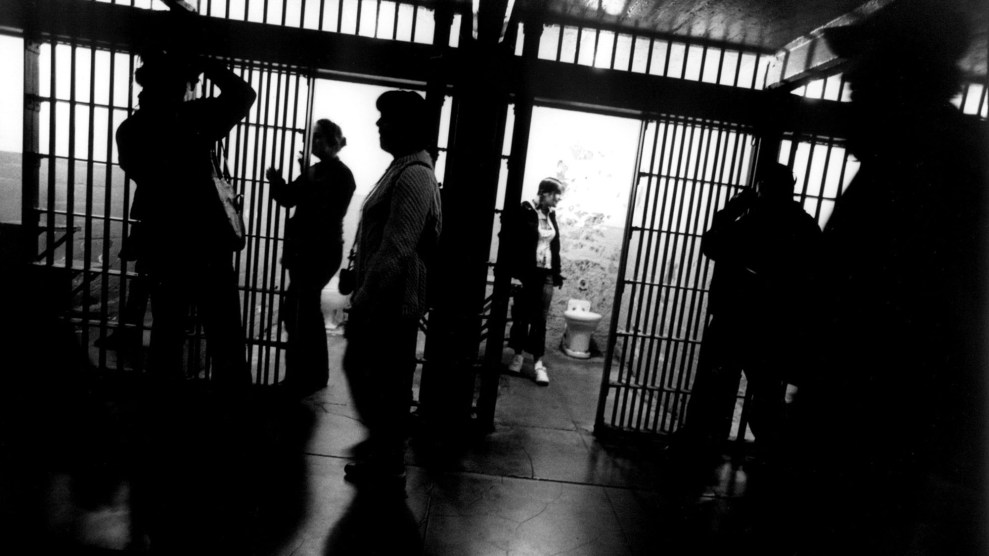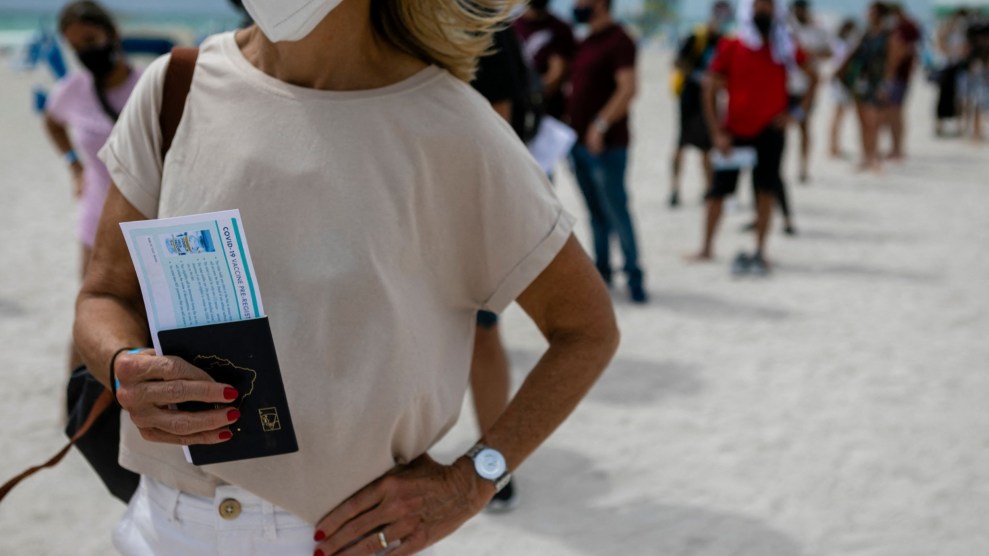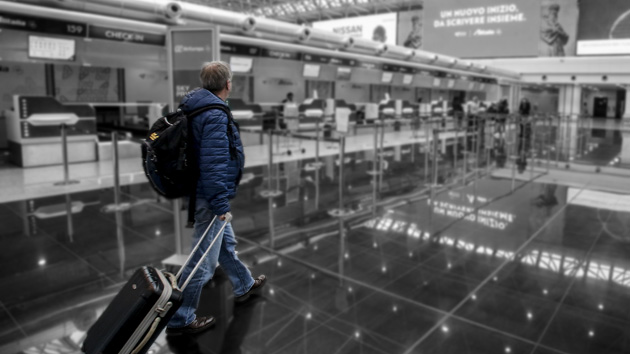
A cruise ship in Antarctica, December 18, 2019. Zheng Xianzhang/VCG/Getty
This story was originally published by Guardian and is reproduced here as part of the Climate Desk collaboration.
Down at the bottom of the Earth during this southern summer, a delicate dance is under way each day, as captains of cruise ships struggle to keep their vessels out of one another’s sight and so preserve the icy continent’s image of wilderness for their customers.
“It’s a very orchestrated ballet as these tourist ships come and go,” says Dana Bergstrom, an ecologist with the Australian Antarctic Division. “There’s a type of cognitive dissonance where visitors pretend they are the only ones in Antarctica.”
The region is home to rich but delicate ecosystems, many of which have been isolated from the rest of the world by the Southern Ocean for 30m years. Its remarkable natural appeal—enhanced by the novelty of fewer than one million people ever having visited—makes Antarctica an increasingly attractive tourist destination.
This summer a record 106,000 tourists will visit, up from 74,000 in 2019-20, the last pre-Covid season, according to the International Association of Antarctica Tour Operators (IAATO). “An Antarctica cruise is the ultimate journey,” the website of the tour operator Chimu promises. “Filled with awe-inspiring wildlife encounters and sensory experiences of indescribable beauty. To see Antarctica is to experience your place in the world from a whole new perspective.”
Hanne Nielsen, a lecturer in Antarctic law and governance at the University of Tasmania, spent five seasons guiding visitors to the Antarctic peninsula and the sub-Antarctic islands administered by New Zealand.
She says the opening of the schedule each year triggers “a mad scramble to book the different slots” by operators trying to secure landings at the permitted sites. “Antarctica is somewhere that’s remote and pristine and far away,” Nielsen says. “If you see a whole lot of other vessels, whether they’re fishing vessels or tour vessels, that can damage that illusion.
“Vessels will try to stay away from each other, around the corner,” she says. “There is an element of choreography involved as it is with any tourism product that’s delivered.”
Peter Carey, a global fellow at the Wilson Centre’s Polar Institute who has spent decades as a researcher and a tour group lecturer, counted 42 cruise ships of various sizes in the region on one recent morning.
In 2020, operators ordered 29 new expedition-style cruise ships for delivery within three years, adding to the 40 or so in service, Carey wrote in an article that year.
“The important step is to actually understand what the cumulative impact [of increased tourism] is and to use that information to make sound regulatory management decisions,” Carey says.
Bergstrom understands the public interest. But she is concerned about the potential threats to Antarctica’s ecology, which she detailed in a recent paper.
The continent’s long history of evolutionary isolation means its biological diversity is much less than that of the Arctic. And Bergstrom says the expanding range of tourism offerings—from kayaking and snowshoeing to an annual marathon on King George Island between Chilean and Chinese research bases—suggests tourism has gone “from nature-based to ego-based tourism, to test your testosterone in Antarctica.”
“Tourism is getting more and more extreme,” she says. “On this scale, it is not sustainable.”
Restrictions imposed by the Antarctic Treaty signatory nations—now numbering 54—limit land-based visits to about 200 hectares, stretched over a region almost as large as France. The treaty regulates issues such as waste disposal, marine pollution, commercial sealing and commercial fishing, but as yet there is no annex specifically addressing tourism.
For now, all activities undertaken in Antarctica by signatory parties need a permit. Tour operators must complete an environmental evaluation demonstrating their activities can be managed safely and with no more than a minor or transitory impact, Carey says. Separate studies of environmental impacts, such as on penguin colonies, have so far “found an absence of negative impact from visitors.”
But Carey says the need for specialized rules will inevitably grow as tourism expands, raising the risk of accidents and the introduction of unwanted invasive species or pathogens such as avian influenza that could prove devastating for wildlife. Caps on visitor numbers to individual sites and the overall region are likely to be part of an eventual solution, he says.
Most tourists now take eight-to-14-day cruises from the Argentine port of Ushuaia, the closest to the Antarctic peninsula. Motivations of visitors vary greatly. For some it will be their final trip, for others it’s “just another place that people go,” after ticking off the Galápagos Islands or some other exotic locale. Luxury is increasingly the norm.
The centenary of the end of the “heroic era” in 2022 fanned interest in explorers such as Scott, Amundsen, Shackleton and Mawson. The 250th anniversary of British explorer James Cook’s voyages—the first known to enter the Antarctic circle—will also be marked this month. Whatever the lure, guides often find their enthusiasm for the region inspires visitors.
Nielsen’s PhD on Brand Antarctica, soon to be published in book form, highlights Antarctica’s place in the popular imagination, with its mix of “heroism, extremity, purity, fragility,”
“You’ve got this whole idea … about Antarctica being a place that is life-changing,” Nielsen says.
But how to balance that against the fossil fuels burned to reach the region, damage to mosses, disturbance from construction of infrastructure and invasive species?
Tour groups encourage visitors to take part in citizen science projects, such as watching whales and other animals or monitoring water quality and clouds, and even to become de facto “ambassadors” for the continent. That “grants them some social license for that tourism operation,” she says.
Gina Greer, IAATO’s executive director, says the industry is well aware of the responsibilities it carries to keep its impact to a minimum. For example, ships sailing beyond 60 degrees south cannot burn dirty heavy fuel oil. “[We’re] always looking to evolve our practices, and to address new and emerging things that are coming out,” Greer says.
She cites IAATO’s new protocols to curb the spread of avian flu, which has led to the deaths of hundreds of thousands of wild birds in the high Arctic and elsewhere, in addition to the usual requirements that clothes and boots of visitors are cleaned and checked for seeds before landings.
Visitors will not be permitted to sit, kneel, or lie on the ground or snow, nor leave any equipment. They must also keep at least five meters from wildlife “where it can be safely done,” the amended rules state.
Among the challenges will be monitoring vessels from operators that are not IATTO members. Two such cruise ships have been identified, and although they are not scheduled to land visitors, the organization will “keep an open communication line with them” to make sure they operate within agreed protocols, Greer says.
She concedes that visitor caps may come, “but it’s really for the treaty party members to make that decision.”
Meg Hall, a manager with Chimu Adventures, says many people visit the area already knowing “how fragile our world is,” and the experience many have being “amongst these beautiful creatures who aren’t afraid of humans … is really something quite extraordinary.”
“They come back absolute advocates for our planet, which is a big win,” Hall says.
The tourism industry is careful to mimic the approach adopted by national research teams, such as taking away all waste. “Nothing stays in Antarctica,” Hall says. “It’s an incredibly pristine location—it’s one of those rare places in the world. We intend to keep it that way.”















